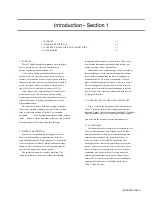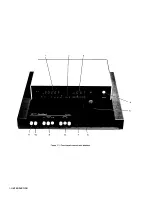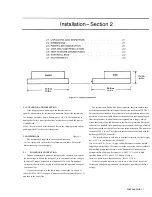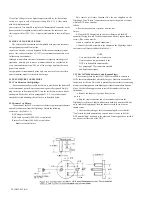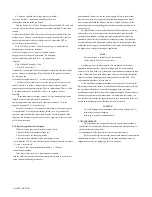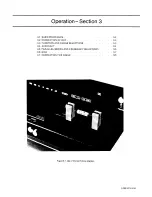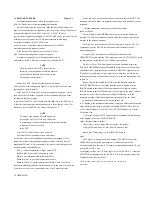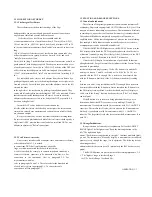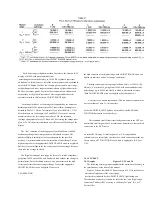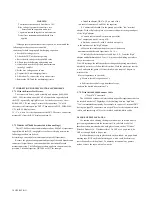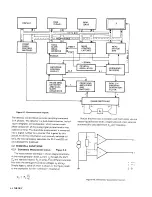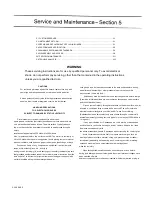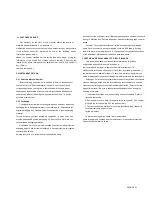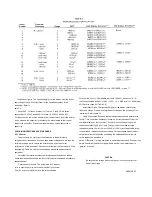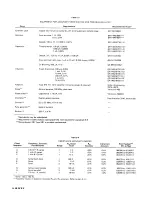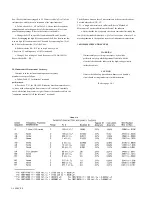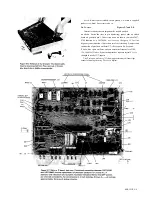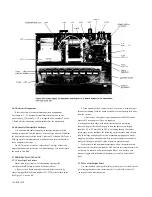
3.5.4 Equivalent Series R for Capacitors.
The total loss of a capacitor can be expressed in several ways, including
D and "ESR." To obtain equivalent series resistance, one can measure
directly (if D is high enough to permit the desired accuracy) or calculate.
Direct Measurement.
If, while measuring C, you observe that D is
above 0.1 (or some other limit of your choice, see Figure 3-3), push
FUNCTION button R and select SERIES.
Both C and ESR should be measured on the same range. If D is below
1, the range should be correct for C, even though the ADJUST RANGE
light comes on while you measure ES R. However, if D is above 1, choose
the correct "R" range to obtain ESR; and then remeasure C on this range.
Calculation.
If D is small, it is better to calculate "ESR" as follows: Rs
= D/2
π
fCs where
π
= 3.1416. D and Cs are displayed on the front panel.
Frequency f depends on the model of the instrument and the selected
frequency as follows (+/- .01%):
1657-9700: "1 kHz" is 1020.0 Hz; "120 Hz" is 120.0 Hz. 1657-9800: "1
kHz" is 1000.0 Hz; "100 Hz" is 100.0 Hz.
"Equivalent series resistance" is typically much larger than the "ohmic"
resistance of the wire leads and foils that are physically in series with the
heart of a capacitor. ESR includes also the effect of dielectric loss and is
therefore
dependent on frequency.
3.5.5 Parallel Equivalent Circuits for Inductors.
Even though it is customary to measure series inductance of inductors,
there are situations in which the parallel equivalent circuit better represents
the physical device. At low frequencies, the significant loss mechanism is
usually "ohmic" or "copper loss" in the wire and the series circuit is
appropriate. If there is an iron core, at higher frequencies the significant
loss mechanism may be "core loss" (related to eddy currents and hysteresis)
and the parallel equivalent circuit is appropriate. Whether this is true at 1
kHz should be determined by an understanding of the DUT, but probably it
is so if the following is true: that measurements
of Lp at 1 kHz and at 120 Hz (100 Hz) are more nearly in agreement than
measurements of Ls at the same 2 frequencies.
3.6 BIAS.
To measure a capacitor with bias applied, it is necessary to insert a bias
voltage source in series with the I+ lead to the DUT and to provide a means
of discharging it. Refer to para 2.6 for installation of the recommended
circuit.
OPERATION 3-7
Содержание 1657 RLC Digibridge
Страница 6: ...Table of Contents...
Страница 8: ...1 2 INTRODUCTION...
Страница 9: ...INTRODUCTION 1 3...
Страница 10: ...1 4 INTRODUCTION...
Страница 15: ...OPERATION 3 1...
Страница 24: ...4 2 THEORY...
Страница 30: ...5 4 SERVICE...
Страница 42: ...5 16 SERVICE...
Страница 46: ......
Страница 49: ......
Страница 50: ......
Страница 51: ......
Страница 52: ......
Страница 53: ......
Страница 54: ......
Страница 55: ......
Страница 56: ......
Страница 57: ......

